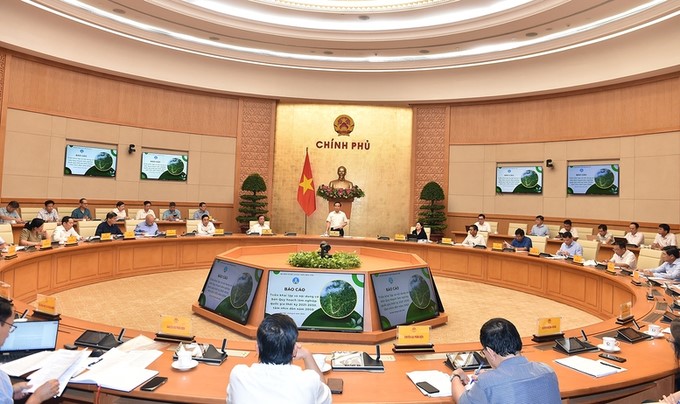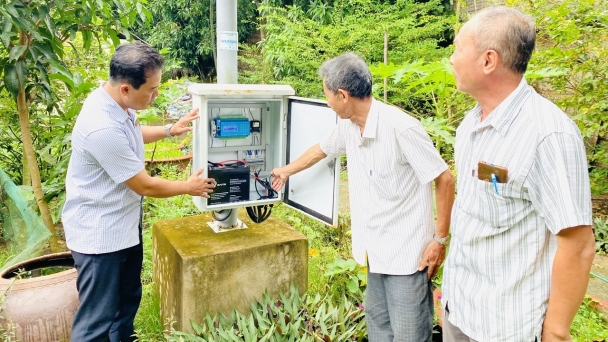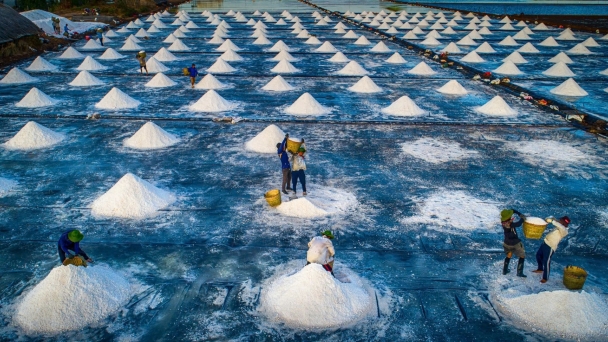December 20, 2024 | 16:32 GMT +7
December 20, 2024 | 16:32 GMT +7
Hotline: 0913.378.918
December 20, 2024 | 16:32 GMT +7
Hotline: 0913.378.918

Forest rangers coordinate with people to patrol the forest. Photo: Yen Bai Provincial Forest Protection and Development Fund.
The Forestry Planning for the 2021–2030 period aims to ensure the maintenance of a stable national forest coverage rate of 42–43% and focus on improving forest quality, especially existing natural forests.
The average growth rate of forestry production value reaches 5–5.5%/year. The export value of wooden furniture and forest products reaches USD 20 billion in 2025 and USD 25 billion in 2030. The value of domestic consumption of wooden furniture and forest products reaches USD 5 billion (converted) in 2025 and USD 6 billion (converted) in 2030.
The annual afforestation reaches an average of 238,000 hectares of production forests and 8,600 hectares of protection forests and special-use forests. The restoration of natural forests reaches an average of 22,500 hectares/year, and the forest area with sustainable forest management certification until 2030 reaches over 1 million hectares.
The output of domestically exploited wood reaches 35 million m3 in 2025 and 50 million m3 in 2030. The value of income from production forests per unit area will increase 1.5 times by 2025 and 2 times by 2030 compared to 2020.
Revenue from forest environmental services increases by an average of 5%/year. The revenue in the 2021–2025 period reaches about VND 3,500 billion/year and the 2026–2030 period collects about VND 4,000 billion/year.
By 2030, 100% of the forest area of forest owners who are organizations will be sustainably managed to improve the efficiency of preserving natural resources and biodiversity and ensure the protective function of forests. At the same time, minimize violations of forestry laws.
The Planning also aims to build the forestry industry into an economic and technical industry by 2050, promoting the potential and advantages of tropical forest resources; applying modern and eco-friendly technology; creating many products and services with high added value, proactively participating in the global value supply chain; and increasingly contributing to the country's sustainable development.

On June 14, the Appraisal Council, chaired by Deputy Prime Minister Tran Luu Quang, voted unanimously to approve the draft National Forestry Planning to be submitted to the Prime Minister for approval.
At the same time, contribute to improving livelihoods, developing a green economy and a circular economy associated with preserving and promoting traditional cultural identity and the living space of ethnic minorities, ensuring the maintenance of national defense and security of the country, etc.
The Planning orients to promote scientific research, select and create new varieties with high productivity and quality, and fast-growing indigenous tree varieties with productivity and quality to serve the development of production forests and large timber forests. Ensure an average supply of 575 million trees/year.
In the 2021–2025 period, 1.18 million hectares will be planted, with an average of 235,700 hectares/year. Of which, 178,400 hectares are newly planted, with an average of 35,700 hectares/year. In the period 2026–2030, 1.29 million hectares will be planted, with an average of 257,800 hectares/year. Of which, new planting is 88,800 hectares, with an average of 17,800 hectares/year. The area of large timber forest planting by 2030 is expected to reach 1 million hectares.
The area of forestry land in the 2021–2030 period is planned to be 15.848 million hectares. Of which, the area of special-use forest land is 2.45 million hectares (accounting for 15.5%), protection forest land is 5.23 million hectares (accounting for 33%), and production forest land is 8.16 million hectares (accounting for 51.5%). The area of forested land is 14.7 million hectares, accounting for 92.7% of the forestry land area.
Pursuant to Decision 895, the Prime Minister assigned the Ministry of Agriculture and Rural Development to be responsible for the accuracy of data, documents, diagrams, maps, and databases in the planning dossier, ensuring consistency and complying with legal regulations.
Within 30 days from the time of approval of the National Forestry Planning, the Ministry of Agriculture and Rural Development completes handing over to localities with forests the 1/100,000 scaled map. Besides, preside and coordinate with Ministries, branches, and provincial People's Committees to implement the Planning.
The Ministry of Agriculture and Rural Development is responsible for periodically organizing reports and evaluating the implementation of the Planning at the end of each medium-term period (2021-2025 and 2026-2030). At the same time, review and evaluate the situation of implementing objectives to report to competent authorities for consideration and adjustment of Planning in accordance with reality in each period.
Previously, on June 14, the Appraisal Council, chaired by Deputy Prime Minister Tran Luu Quang approved the draft National Forestry Planning. Over the past 2 months, the Ministry of Agriculture and Rural Development has continued to perfect, absorb, and edit before submitting to the Government for official promulgation.
Translated by Thu Huyen

(VAN) Recovering degraded soil is a prolonged, enduring process that demands solutions on mechanisms, policies, infrastructure investment, science technology and agricultural extension, etc.

(VAN) It can be affirmed that cooperatives are a key factor in helping Dong Thap Province restructure its agricultural sector, aiming for sustainable production and adaptation to market demands.

(VAN) The Central Highlands will experience a variety of negative consequences if they fail to implement comprehensive solutions to preserve soil resources, which will increase the area of degraded land.

(VAN) The anticipated tariff disputes, led by the incoming Trump administration in the United States, are set to target imports from China, Mexico, Canada and many other countries.

(VAN) The Salt Industry Festival 2025 is anticipated to enhance the salt-making industry in Bac Lieu province and serve as an encouragement for salt farmers to maintain their dedication to this historic traditional craft.

(VAN) An updated code for sustainable compound feed and livestock production in the European Union have been endorsed by the European Commission’s Standing Committee on Plants, Animals, Food and Feed (SCoPAFF).

(VAN) The scheme on developing salt industry between 2021 and 2030 approved by the Prime Minister would elevate the salt production area to 14,224ha, with the output reaching 2 million tons/year.